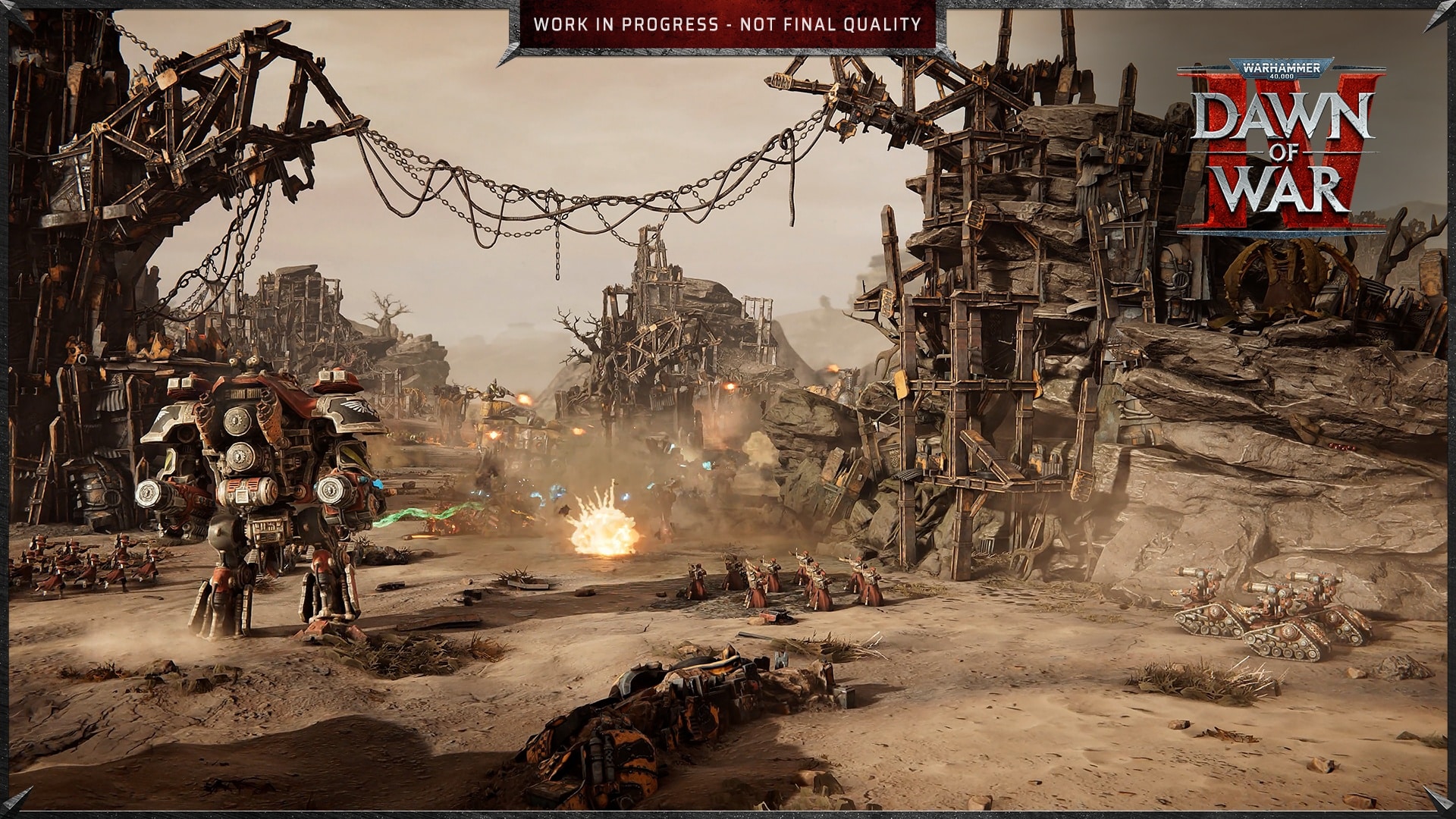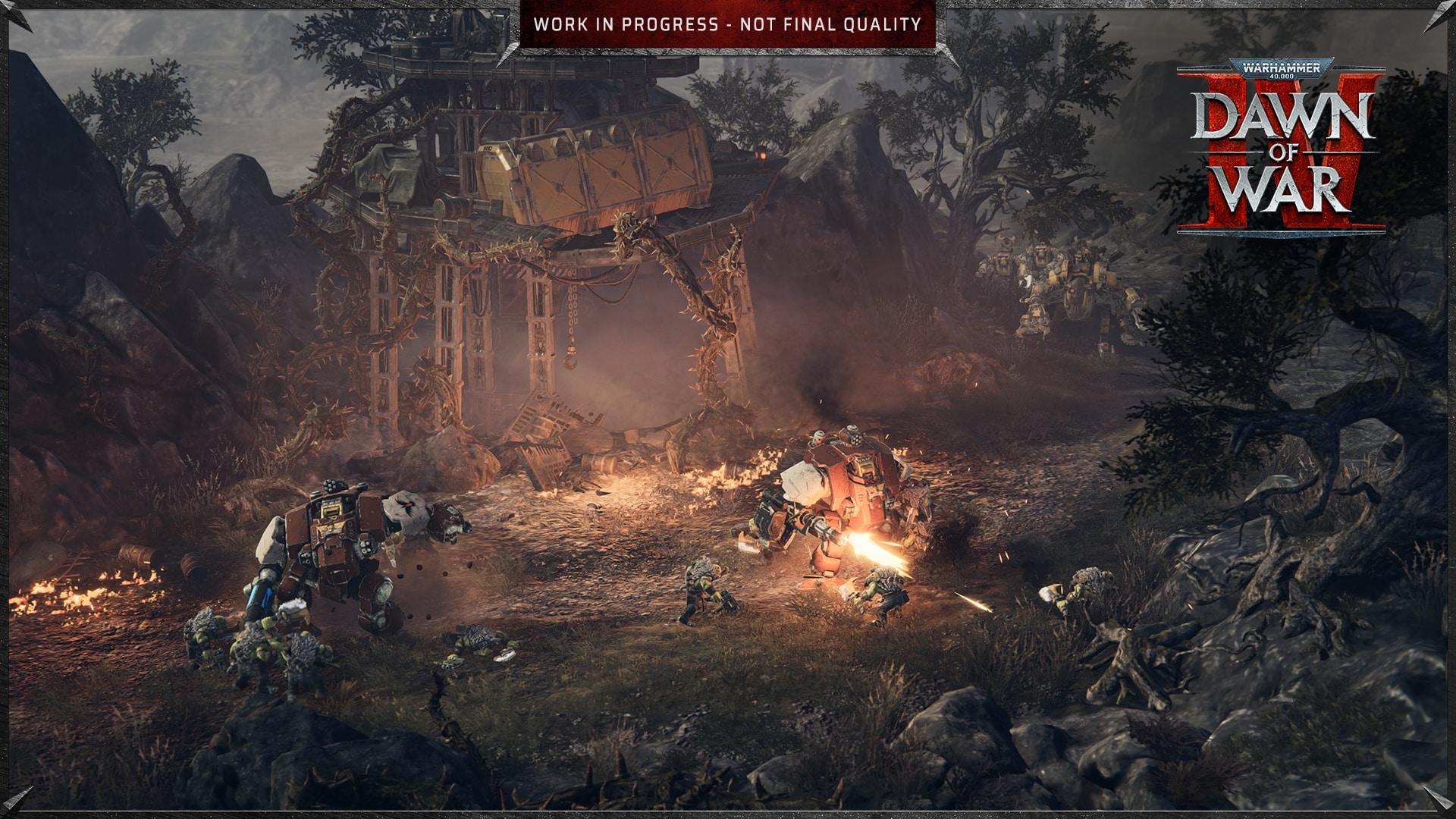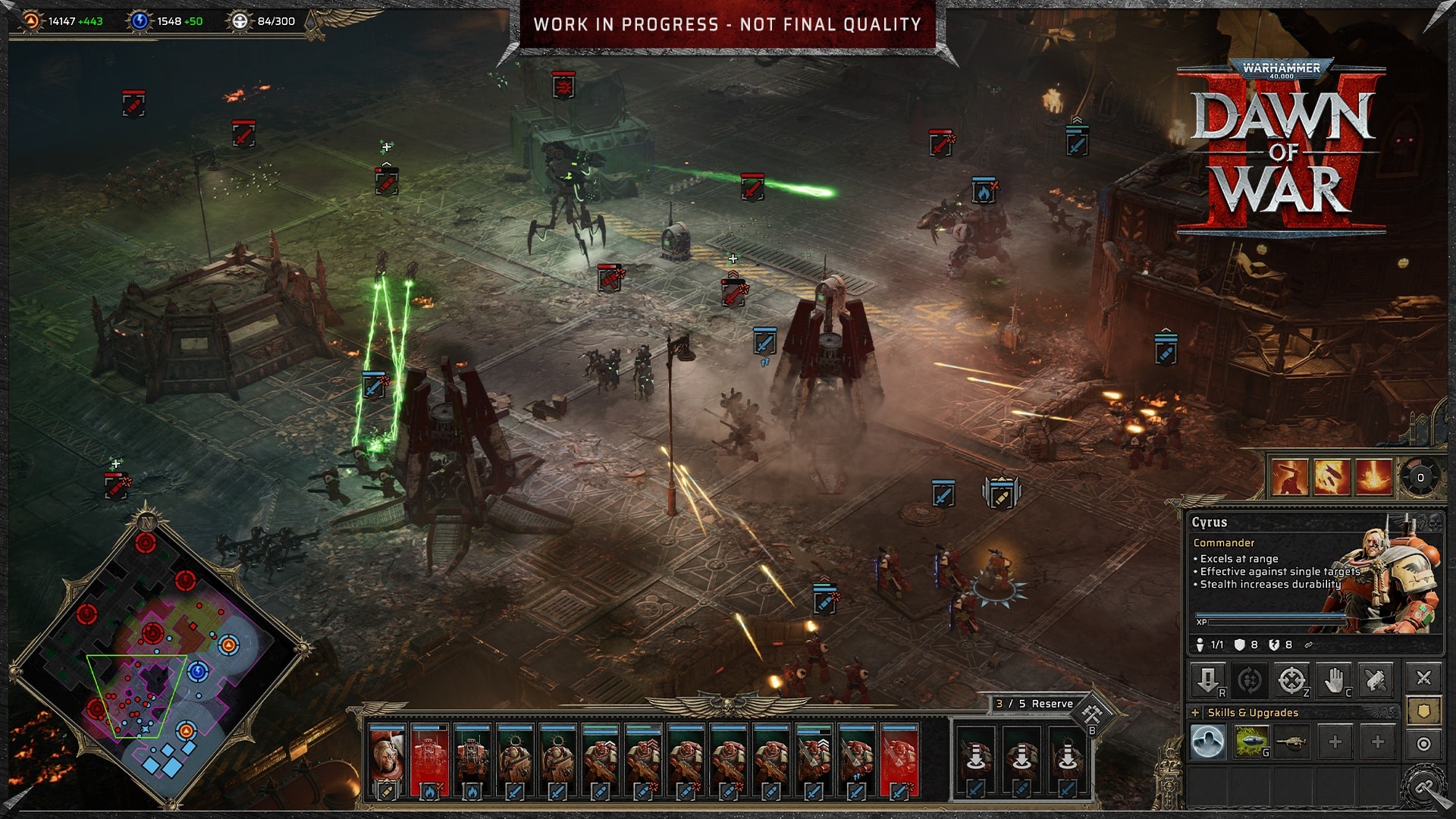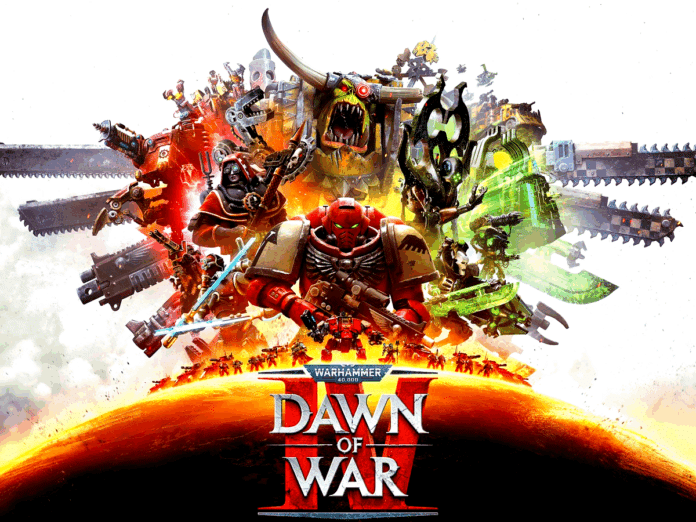Out of nowhere, Warhammer 40,000: Dawn of War 4 is announced at gamescom 2025 – and it comes from people who know what they’re doing.
I never expected Dawn of War 4. Some franchises crash and burn with no chance of recovery – hello, C&C4 – and Dawn of War 3 seemed to be exactly that. It was supposed to bring the brand back after years of hiatus, and with Relic, even the original developer was on board.
But the final game disappointed fans across the board and was dropped by the studio immediately after release. Quite the exterminatus. But I was more wrong than Fulgrim.
Almost eight years later, a new studio is taking on the brand, and it’s a perfect fit for Dawn of War: the German team King Art from Bremen released the strategy game Iron Harvest in 2020, which is basically Company of Heroes with giant mechs. And since Company of Heroes is a spiritual successor to Dawn of War and has mechs and stuff… well, you see the connection.
So: Dawn of War 4. King Art isn’t shying away from the big reveal here; Dawn of War 4 is set to bring back all the strengths of the first installment. It offers four factions with four thick single-player campaigns right at release, as well as co-op, skirmish, and multiplayer. On top of that, it looks good enough to eat!
The Space Marines’ bolters spray through rows of Orks, the Necron monoliths razor the landscape, and the Tech-Priests’ heavy Imperial Knights trudge over the hilltops.
Will it be any good? Good question! I’ve already had a chance to play Dawn of War 4 and have at least some initial impressions of the gameplay.
What’s in Dawn of War 4?
But first, let’s clarify the most important information about the game: As already indicated, Dawn of War 4 will be a classic real-time strategy game in the vein of the first installment of the series and Company of Heroes. You quickly build your base, produce a few troops, and send them across the map to capture control points.
Checkpoints give you resources, which you can invest in upgrades and new units to eventually overwhelm your opponents. Dawn of War 4 is limited to two resources – requisition and energy – so fans of the original will find their feet in no time.
The scenario should also be familiar to veterans: Once again, you’re heading to the tomb world of Kronus, which you last conquered in the second Dawn of War add-on, Dark Crusade. The story takes place 200 years after Dark Crusade, but little has really changed. The Blood Ravens return to the planet and are expected to face a lot of war.
Fans are looking forward to reuniting with old acquaintances. On the Space Marines side, for example, Scout Cyrus takes to the field, and the Orks are led by good old Gorgutz, who apparently just can’t be killed. Speaking of factions, at launch, Dawn of War 4 lets you slip into the shoes of four fundamentally different races:
- The Space Marines beat mass with class. They rely on fewer units, but these are the absolute elite of the Empire. Among them are the classic Intercessors with heavy bolters, but of course you also recruit Terminators, Scouts, close combat fighters, and powerful Dreadnoughts.
- The Orks are the exact opposite of the Space Marines: the Boyz attack you with countless hordes of thick and thin, large and small green-skinned creatures and fight their way into a Waaargh rage, which in turn unlocks powerful stratagems. Of course, Orks still have thick units, including the powerful Gorkanaut walkers.
- The Necrons are guaranteed to be the most annoying enemies in Dawn of War 4 again because they heal themselves, teleport, simply refuse to die, and in the late game, they laser away entire regiments with their cursed monoliths after assimilating the entire map.
- The Adeptus Mechanicus is my personal favorite among the factions because the Tech-Priests simply have the weirdest weapons. Their Skitarii shooters are more machine than man, and the powerful Imperial Knight Mechs stomp across the map. Thanks to advanced technology, they can detect enemy movements even in the Fog of War, and they also distribute special nodes across the map that buff their units.

In the tutorial, you also take on the role of the Imperial Army, which is not playable on its own. I can well imagine that the Imperial Guard will be one of the first factions to be released as DLC after launch.
So, enough groundwork, let’s jump into the match.
How does Dawn of War 4 play?
The gamescom demo I played lasts about 30 to 40 minutes and is a pre-made skirmish scenario. The factions are predetermined: I fight as the Blood Ravens against the Orks – it couldn’t be more classic. The scenario is framed by a bit of story fluff: The Imperial Army is struggling against the green-skinned creatures, so the Blood Ravens, led by Cyrus, swoop down from the sky to bring justice.
After that, I expected non-stop action, but in the midst of all this chaos, I spotted three things that Dawn of War 4 is already doing really well in my opinion.
1. Dawn of War 4 packs exactly the punch it needs to pack
This may sound like a minor detail, but splattering Orks with my Space Marine bolters feels exactly as powerful as I want it to. In fact, the feeling in Dawn of War is anything but trivial: one of the biggest criticisms of Dawn of War 3 was the lack of impact from the units.
Space Marines didn’t feel like the imperial elite, but like ordinary ground troops. Dawn of War 4 fixes that: when the Blood Ravens fire their bolters into the crowd, I can literally feel the fist-sized projectiles detonating.
King Art has invested an incredible amount of detail into designing hundreds of versus animations – for example, a Dreadnought Walker grabbing and crushing an Ork is a hand-crafted sequence of movements.
But Space Marines don’t just dish it out, they also take so much that I really feel like I’m part of the elite.
Some squads consist of only three units, but they’re almost impossible to kill.
The demo mission already has the flow I want: I create two groups of units consisting of melee and ranged fighters and move across the map from checkpoint to checkpoint. Resistance is crushed, and I build defensive turrets on captured nodes to make recapture more difficult.
During the mission, secondary objectives occasionally make progress more difficult. For example, the Orks are working on powerful Gorkanaut tank destroyers – I have to be quick to catch them before they’re finished. And then Necrons suddenly plow across the map; luckily, the Tech Priests rush to my aid and a spectacle of rockets, explosions, and destruction ensues, the likes of which I haven’t seen in the strategy genre in a long time.
2. Dawn of War 4 offers a wonderful array of upgrades
Dawn of War 4 follows the design philosophy that even lowly starting units can become deadly endgame units with enough experience and upgrades. This was one of the strengths of the original game: I could manually upgrade my Space Marines with rocket launchers, plasma launchers, and energy swords to turn them into even more deadly killing machines.
Dawn of War 4 already offers a lavish variety here: I decide for myself whether my Terminators fire slow dumdum bullets over huge distances or get up close and personal with flamethrowers. My units can be reinforced and upgraded on the field:
I equip my colleagues with hammers and swords, opt for stalker bolters or autocannons, and so on.
In addition, each unit gains experience points over time and levels up. This allows me to breed my very own elite Space Marines, who will eventually single-handedly tear apart entire hordes of Orks. At the same time, every loss of a unit feels like I personally let Private Ryan get run over by a tank. Real heartbreak.
3. Dawn of War 4 is not Dawn of War 2
The Dawn of War series has the unfortunate problem that parts one and two are a) fundamentally different and b) both quite popular. Two of my best friends swear by Dawn of War 2 with its strong focus on individual units, which feels much more like real-time tactics, especially since it reduced base building to an absolute minimum.

One thing you need to be clear about here is that Dawn of War 4 is very much based on the first game, so you get a much more impressive battle experience, but also a very zoomed-out perspective.
However, the game still incorporates some of the strengths of the second game:
- As mentioned, units collect experience points and level up, which makes them better and better over time.
- The strong focus on hero units, which also level up and unlock new skills.
- The co-op mode, about which I don’t have any detailed information yet.
- In addition, there will be decisions within the campaign that lead to different campaign scenarios.
However, what Dawn of War 4 seems to be completely lacking so far is a morale system. This is a shame, because it would have given the Orks an interesting tactical edge, as the green-skinned creatures have a chronically unstable work ethic.
The cover system also seems much more rudimentary than in the first and especially the second installment; here and there I encounter a unit behind cover, but the whole thing seems to be of very minor importance.
General: Of course, many questions remain unanswered about the new Dawn of War. Will the four factions be reasonably balanced, how will co-op work in practice, will the campaigns offer exciting missions, and so on and so forth. But I can already say two things for sure:
- The 30-minute demo feels very much like Dawn of War, although I have to ignore the usual alpha glitches, of course. The game is jerky and sluggish, many graphics are still placeholders, and so on.
- The game has the right focus.
Where Dawn of War 3 was still very obviously trying to tap into the MOBA hype of League of Legends and show off its multiplayer capabilities, the fourth installment feels like a remake of the first game. King Art seems to have understood exactly what made it so great: powerful units, charismatic heroes and villains, and a focus on the front line.

Base building does play a role, of course. For example, I have to decide whether I’d rather build upgrade buildings for my marines or vehicle hangars or defensive bunkers, but part four really picks up the pace here – there aren’t even any servitors!
Instead, I call buildings down from the sky, quickly construct them, throw a few units into my queue, and focus back on what’s really important: the skirmishes around the control points, where my Space Marines beat up everything that isn’t back in space by the count of three. That’s right.
At the end of my demo mission, I push the Orks back into their base. In a last-ditch battle, they throw everything they’ve got at me, including huge battle vehicles, but I call in carpet bombing from the air and have recruited so many Terminators that the enemy doesn’t stand a chance.
As I said at the beginning: I never expected a Dawn of War 4. But now that it’s almost here, I can’t wait for any other strategy game to come out. At least King Art has already achieved that.
Editor’s conclusion
Even 20 years later, the first Dawn of War is still a real firework display of real-time strategy – I should know, since I finally caught up on the main game and all the add-ons just two years ago during a wild Christmas vacation. The game not only perfectly captures the over-the-top spirit of Warhammer 40K, but is also a masterpiece of game design beyond the license: Varied campaign missions, great units, fast-paced gameplay – no wonder Relic jumped on the bandwagon with Company of Heroes back then. And Dawn of War 4 wants to bring all that back? Hell yeah, I’m on board. Of course, I can’t make any final statements after 30 minutes, but at least on paper and at first glance, developer King Art seems to be doing exactly the right thing: preserving the strengths of the past and only revising where it’s possible to do so smoothly. For example, my units now collect experience points. And of course, the game looks pretty amazing. The reveal of Dawn of War 4 hits all the right notes. The devs talk a lot about the campaigns, elaborate cutscenes, references to Dark Crusade, and exciting unit synergies. What they hardly talk about: multiplayer, live service, roadmaps, MOBA, trends – this could be cold calculation, of course, or it could be a damn good sign.


